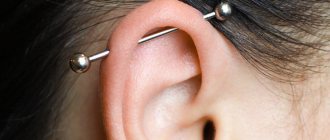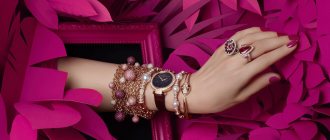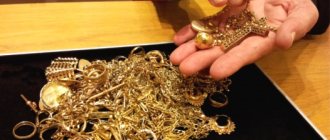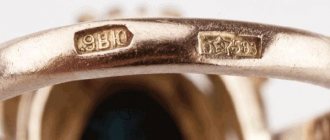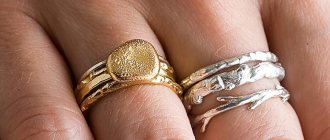Content
- At what age can you get your ears pierced?
- Is it harmful for a girl to pierce her ears too early?
- How does the time of year affect a child's ear piercing?
- How to prepare your ears for piercing
- How to speed up healing after ear piercing
- Where is the best place to get your ears pierced?
- How to pierce ears
- When should you not pierce your child's ears?
Earrings are one of the first jewelry that girls wear. Parents who want to pierce their little ones' ears are wondering where and when is the best time to do it, what is the best piercing method, and how to prepare? There is no consensus on when it is best to pierce a girl’s ears. Some do this as early as six months, while others last up to 5-6 years or more.
At what age can you get your ears pierced?
Parents and especially grandmothers are often against early piercing, but what do experts say? Psychologists advise having your ears pierced before the age of one, and sometimes even indicate the exact age - 8-9 months. The reason for the puncture at such an early age is explained by the increased pain threshold, and the child immediately forgets the trauma he suffered.
Pediatricians have their own opinion on this matter. They advise that a child's ears should be pierced after three years of age due to the risk of infection. At three years of age, the immune system is stronger, so the likelihood of catching an infection is less, and it is easier to cure it. Pediatricians also assure that the child will be able to explain the need for the procedure.
Experts also recommend piercing the ears of a child under 10-11 years old, so that after the wounds heal, keloid scars do not form. A cosmetic defect upsets the parents and the girl herself.
Often, parents wondering whether it is possible to pierce their young children’s ears decide to postpone this procedure until the girl herself expresses a desire to wear earrings. This happens both at 3 years old and at 10 years old - always in different ways. It turns out that all people have different attitudes towards piercing a child’s ears, but there are several pros and cons, which we will now consider.
Should you get your ears pierced early or not?
It is impossible to say unequivocally when it is possible to pierce a child’s ears, so we will consider the positive and negative aspects of this procedure at an early age to make it easier for you to decide.
Arguments against"
- Regardless of sterile conditions, there is a risk of infection. There are also points on the earlobe that influence the baby’s thought processes and development.
- An allergic reaction to nickel in the alloy is possible.
- Some consider earrings inappropriate for girls aged 1-2 years, but this is a very controversial point.
- A child may get caught on something in the decoration during active play, damaging his ear.
- A little girl can lose an earring and even swallow it.
Arguments for"
- Earrings on a girl are beautiful, and on the playground no one will confuse your baby with a boy.
- The pain threshold in children is higher. Of course, the child will cry or scream, but will soon calm down and forget about everything.
- After 11 years of age, the likelihood of scarring on the earlobes increases.
Pros and cons
Public opinion on early piercing is divided. Proponents of piercing a child under 3 years of age put forward their arguments:
- No fear or bad memories in the future. According to psychologists, the painful process will not upset a baby so much at the age of 7-10 months or even a year. The baby is quickly distracted and forgets about the offense. And three-year-old girls can get psychological trauma, stress, and phobias.
- The original appearance of the tiny princess. The earlobe, decorated with gold and silver earrings almost from birth, causes great delight among parents and strangers on the street.
- At an early age, the wound will heal faster.
Pediatricians and more cautious parents have their reasons for postponing the piercing of a baby’s ear until the age of 3 or to a later period:
- The traumatic procedure will cause pain to the baby.
- The cartilage in the ear is still developing, and it can be accidentally damaged during the procedure.
- Low infant immunity.
- Restlessness, inexperience of the child. A baby may twitch its ears when interested in an unusual object. If you manage to rip off or unfasten an earring, you will definitely taste it.
- Danger to the life and health of the baby. The earlobe contains important nerve endings. Their accidental damage can harm the development of the child and provoke pathologies of the central nervous system.
- Allergenicity of jewelry material. Earrings may contain nickel, which causes allergies. The ear may turn red immediately after putting it on in the salon and will hurt.
Best time of year to get your ears pierced
Parents planning to pierce their child's ears often do not think about when and at what time of year to carry out the procedure. Experts have recommendations on this matter that are worth listening to:
- In the winter season, doctors do not recommend piercing their ears, as they can get cold, and children also wear knitted hats and turtlenecks, which can get caught on the earring and injure the earlobe.
- The best period for this procedure is the beginning of spring and the end of autumn. The reason is similar to the above.
- In the heat of summer, due to the high temperature and dry air, the risk of infection in the wound increases, and healing is also greatly delayed.
- The best time is September or May. During these months it is not too hot, like in summer, and knitted hats and sweaters are no longer worn. The chances of quick and problem-free healing of the earlobes are highest.
Thus, you need to take into account not only at what age the puncture should be done, but also remember the time of year.
What time of year should the procedure be performed?
Why does the time of year matter? It seems that the earrings look equally beautiful both in summer and in cold weather. However, when it comes to children's health, it is important to take into account all sorts of factors, including the time of year.
- Winter is not suitable for ear piercing. Just imagine - cold weather, turtlenecks and sweaters, hats. You or your child may catch your earring on a knitted item and injure your ears.
- For the same reason, the transition periods - March and October-November - are not suitable for ear piercing.
- The summer months are also not the best time for piercing. Hot weather will increase the risk of infection and slow healing.
- The ideal time period is May and early autumn. During these months, the heat subsides or has not yet begun, and knitted clothes are not yet worn. And all wounds heal much faster.
It is curious that folk superstitions also favor the latter option, considering the best time for ear piercing to be the blossoming period of apple trees – that is, May.
Preparing for ear piercing
Getting a child's ears pierced is a very important responsibility, even though the procedure is simple. It’s worth preparing for it and finding a good place with an experienced master who will do everything carefully, correctly and painlessly. Smart mothers always start with medical advice. You should take the time to visit the following doctors and consult with them:
- Pediatrician. Conduct a general examination and recommend diagnostic procedures such as blood tests and checking blood sugar concentrations.
- Ophthalmologist. The earlobes, as strange as it may sound, are connected to the visual organs. The connection is due to nerve fibers, so if your vision is impaired, it is better to postpone ear piercing.
- Allergist. All alloys contain nickel compounds that provoke allergic reactions in case of hypersensitivity of the child's body.
Parents should be aware that the piercing procedure is stressful for the child, so he needs to be prepared. Remember and consider the following recommendations:
- Only completely healthy children can have their ears pierced. Even if the girl has a cold or is sick with something else, postpone the procedure for a more appropriate time.
- Prepare your child and explain where you are going. There is no need to hide anything so that the baby can tune in.
- If the girl is old enough (over three years old), try to interest her by involving her in the process of choosing earrings.
- Prepare some kind of gift for courage that the child will receive after the procedure.
- It is necessary to establish contact between the master and the child.
Rules of care for healing
It is necessary not only to pierce correctly, but also to properly care for the lobes afterwards. Complete healing usually lasts from a month to three, and the following is required from parents:
- Explain to the girl that jewelry should not be touched, especially if your hands are dirty.
- You cannot change earrings until the wounds have healed.
- During healing, it is better to put your hair in a ponytail or make a braid.
- Twice a day you need to treat your earlobes with antiseptics. Experts usually recommend hydrogen peroxide or chlorhexidine.
- Five days after piercing, start turning the earrings around the axis.
- After piercing your ears, it is not advisable to get them wet for the first 4-5 days.
If you find yellowish discharge from the wounds, treat them with a light solution of potassium permanganate. The pus should disappear in a couple of days, but if this does not happen, go to the doctor - the suppuration cannot be left, and it is unlikely to go away on its own.
How to carry out the procedure correctly
Any part of the ear should be pierced according to the instructions. The procedure is carried out wearing sterile gloves and disposable instruments. It is strictly forbidden to perform piercing at home. The technique may vary depending on the type of modification.
needle
The procedure lasts several minutes.
Stages of implementation:
- Preliminary processing. Before puncturing, the master must thoroughly disinfect the epithelium. A cotton or gauze swab is moistened in ethyl alcohol, Miramistin or Chlorhexidine. Gently wipe the ear at the site of the intended puncture. Movements should be light and slow. Antiseptic treatment helps remove dirt and bacteria.
- Preparing tools. The master opens sealed packages with disposable sterile needles directly in front of the client within a minute of the intended puncture. He must work with gloves. The needle is additionally wiped with a swab soaked in Miramistin, Chlorhexidine or ethyl alcohol.
- Puncture. The master holds the auricle with the fingers of his “non-working” (usually left) hand. With the “working” limb, the piercer performs a puncture, inserting the needle horizontally. Remove the instrument carefully, trying not to make sudden movements. The second ear is pierced according to the same scheme, and earrings are inserted into the hole. Consumables (used materials) are subject to complete recycling.
After the puncture, the master re-processes the working area. The wound is wiped with an antiseptic and covered with a plaster. The earrings are tightened with plugs on the reverse side. The carnations are removed after the wound has completely healed and rods, spirals or other decorations are inserted.
With a pistol
The procedure of piercing the ear with a gun also lasts a few seconds. The earrings that are inserted into the device are made of titanium and high-quality hypoallergenic steel. The materials are almost completely biocompatible with the human body. Thanks to the tool, you can painlessly and quickly pierce your earlobe.
The procedure takes place in several stages:
- the ear is wiped with ethyl alcohol, miramistin, furatsilin or any other antiseptic solution;
- Mark the puncture site with a marker (it is important to ensure that the points are completely symmetrical);
- the lobe is placed between the plate and the cartridge;
- pull the trigger and remove the gun from your ear.
The puncture is carried out not with a needle, but with the stem of the earring. It is strictly forbidden to touch the lobe with your hands. The master tightens the earrings by installing metal or silicone plugs on them on the reverse side.
Where to get your ears pierced?
The next stage is choosing a good salon or medical facility where the procedure will be performed. Every parent should understand that the procedure should not be done at the nearest hairdresser. Don’t be too lazy to turn to professionals at a clinic with a good reputation - in this case, your child will not get an infection.
An experienced specialist knows the safest puncture points and carries out the procedure completely painlessly and without complications. Parents should make sure that all instruments and earrings are sterile.
Good clinics offer jewelry made from high-quality medical alloys. They are loaded into a special gun and used to pierce the earlobe, and when the wounds heal, the parents remove the earrings and insert any others.
How to treat ears
By observing the basic rules of hygiene of the wound in the lobe, mothers will be able to save their daughters from suppuration and complications after piercing. Instructions for caring for your ears are as follows:
- Do not remove or change earrings worn in the salon for 2 - 3 months , thereby avoiding injury to the wound.
- Treat the earlobe and earring with antiseptics three times daily . Use chlorhexidine, hydrogen peroxide. It is not recommended to smear with alcohol or streptocide . If the earlobe breaks out, quickly begin to treat it with Vishnevsky ointment and other means.
- When processing, rotate the nail along the axis . Make movements with the bow so that dirt does not stagnate inside the wound. Be sure to pull the entire surface of the earring out and wipe it. Wash your hands thoroughly before doing this.
- Do not remove the dried crust from the wound . It will disappear on its own.
- Pull your baby's hair up into a ponytail to avoid infection in her ears.
- Use medical glue to speed up wound healing.
- Avoid swimming in open water , getting dirt, soap, and cosmetics on your earring and earlobe.
- Limit your child's physical activity for 1 to 2 weeks after the procedure .
Sweating can negatively affect tissue regeneration. If dirt or dust gets in, the ear can become inflamed.
Ear piercing methods
Parents are always interested in ways to pierce girls' ears. There are several options, among which you can choose the appropriate one, but in the first place is perfect sterility!
Needle
The most primitive method of piercing involves the use of a special disposable catheter needle. The procedure has the main advantage of being able to choose a needle to fit the size of your earlobes. You can also put any earrings into pierced ears, not just standard studs. Puncture with a needle is done simply:
- the ears are thoroughly disinfected on all sides;
- the puncture site is outlined;
- punctures are made;
- earrings are inserted;
- A healing cream is applied to the earlobes.
Often, needles cause fear in children, and the procedure is slow and painful, so it is better to use this method at an older age - from 8-10 years. And despite the fact that many are ready to pierce their ears on their own, we still recommend entrusting this process to a specialist so as not to damage the earlobe during the piercing. For those who are confident in themselves, we suggest watching a video on how to pierce your ears yourself.
Gun
Before piercing her ears with a pistol, the girl’s earlobes are disinfected and the puncture points are marked. The previously selected stud earrings are charged into the device. The lobe is inserted into a special slot at the end of the gun, after which it is fired. The puncture is made not with a needle, but with a charged earring. The procedure takes a minimum of time, and small children are usually more afraid of the click itself rather than the pain. After the procedure, the ears are treated with a healing cream.
The technique has one drawback compared to the needle. The hole is not perfectly smooth, but a lacerated wound appears, which is why a keloid scar remains. Despite this, the gun is better suited for piercing the ears of very young girls.
System 75 tool
The standard gun described above is a reusable instrument that accepts sterile earrings. The tissue is torn and a loud click is heard. The System 75 medical instrument is disposable and therefore has absolute sterility.
Externally, the device looks like a stapler with a disposable cartridge. The specialist does not even touch the jewelry, and the special sharpening of the tips of the earrings prevents tissue tearing and the formation of a torn wound on the earlobe. Thanks to this, it heals quickly, and the likelihood of complications and other negative consequences is reduced to zero. The piercing procedure is also painless and almost silent, so the child tolerates it relatively calmly.
Types of ear piercings, pros and cons
There are several ways to properly pierce your ears.
The technique may vary depending on the puncture location:
- lobe piercing;
- tunnels in the ears;
- cartilage piercing;
- tragus piercing;
- shell puncture.
The puncture procedure has a number of advantages and disadvantages. The size and type of jewelry may vary depending on the location of the piercing.
Classic lobe piercing
An earlobe piercing can be considered a classic piercing option. Before marking the piercing site, the master visually divides the lobe into 9 squares.
The specialist draws a dot exactly in the center with a black marker. The area is pre-treated with alcohol. The puncture can be horizontal or vertical.
Tunnels
Tunnels in the ears are also a kind of piercing. Typically, such jewelry is worn by young people who are committed to one or another informal subculture. According to reviews, the puncture procedure is quite painful. It has a number of contraindications.
It is strictly forbidden to insert tunnels into the ears if a person has:
- at the time of puncture the temperature is increased;
- mental, neurological or vegetative disorders have been diagnosed due to alcohol abuse;
- blood diseases associated with poor blood clotting, diabetes mellitus, and epileptic seizures were previously identified;
- at the time of the puncture, any chronic diseases worsened.
The period of bearing a child and breastfeeding is considered an absolute contraindication.
Few people know that it is impossible to install a tunnel in the ears in one session. The lobe is stretched gradually.
The puncture and stretching procedure takes place in several stages:
- pierce the lobe in the center with a sterile needle;
- thread an earring (usually a stud);
- after 14 days, the earring is removed and an expander with a diameter of no more than 2 mm is inserted.
The dilator is changed every 2 weeks. The lobe should be regularly treated with various antiseptic solutions. While wearing jewelry, a person may experience pain.
Helix (cartilage piercing)
Helix is a puncture of the cartilage tissue in the upper part of the organ. The procedure is quite common. If you make several punctures, you can create a composition from earrings and jewelry. Despite the simplicity of the procedure, experts do not recommend performing it at home.
Processed with VSCOcam with j6 preset
The puncture is performed in the salon with sterile instruments. After processing the organ, markings are placed in the right place with a marker. The earlobe is pierced through, the earring is inserted with a tapper and the hole is covered with a band-aid. On the reverse side, a silicone muffler is put on the nail.
Industrial
Industrial is one of the most dangerous types of conch piercings. Several holes are made in it and connected to each other by means of a rod. Usually the earring is threaded from the bottom up. The extreme modification method is usually chosen by extravagant people. The cartilage at the top of the ear is pierced through. The tissue takes quite a long time to heal; a person experiences acute pain for 6-10 months. Throughout the entire period, lymph and ichor are released from the wound.
The process will go faster if a person has a strong immune system. Various chronic diseases slow down the healing process. The risk of complications can be reduced if you first insert not a barbell, but 2 nails into the hole. It is strictly forbidden to carry out the procedure yourself at home.
When contacting a specialized salon, first of all, the specialist selects suitable jewelry in accordance with the parameters of the auricle.
- The specialist explains to the client the nuances of further cartilage care.
- Before performing a puncture, all instruments and materials are thoroughly sterilized.
- The client is asked to fill out a form and sign consent to the procedure.
- The puncture sites are treated with an antiseptic solution, markings are applied to the skin and the cartilage is pierced through with a needle.
- After the rod has been inserted into the sink, the wounds are treated with a disinfectant solution.
You can cover the hole with adhesive tape.
Tragus (tragus piercing)
Tragus can be considered one of the varieties of extreme piercing. A hole is made in the ear tragus. A stud or earring is inserted into it. Standard jewelry is not suitable for wearing. Experts recommend choosing earrings with a thin, long stem. Studs should be made of hypoallergenic metal (for example, silver, gold).
A puncture is made in the concha cartilage, which is located near the auditory canal, next to the orbital facial joints. The markings are placed in the center, perhaps shifted 1-2 mm upward. The puncture is carried out with a sterile needle.
Snug (conch piercing)
Snug is a rather painful procedure, so piercing is performed under local anesthesia. A hole is made on both sides of the antihelix (left and right).
Suitable decorations must be selected in advance. Snug, like any piercing, is carried out with a sterile needle or a special device. Before piercing, the master explains the essence of the procedure and the nuances of further care for the damaged part of the organ.
Contraindications for ear piercing in children
Finally, let’s find out when it’s better not to pierce your ears. The medical procedure is associated with some risks, although minimal, so you need to remember about contraindications, including:
- disturbances in the composition of the blood (poor clotting);
- diabetes;
- weakened immunity;
- ongoing diseases;
- tendency to allergies;
- low pain threshold.
Doctors also advise against piercing children’s ears during the period of routine vaccination.

